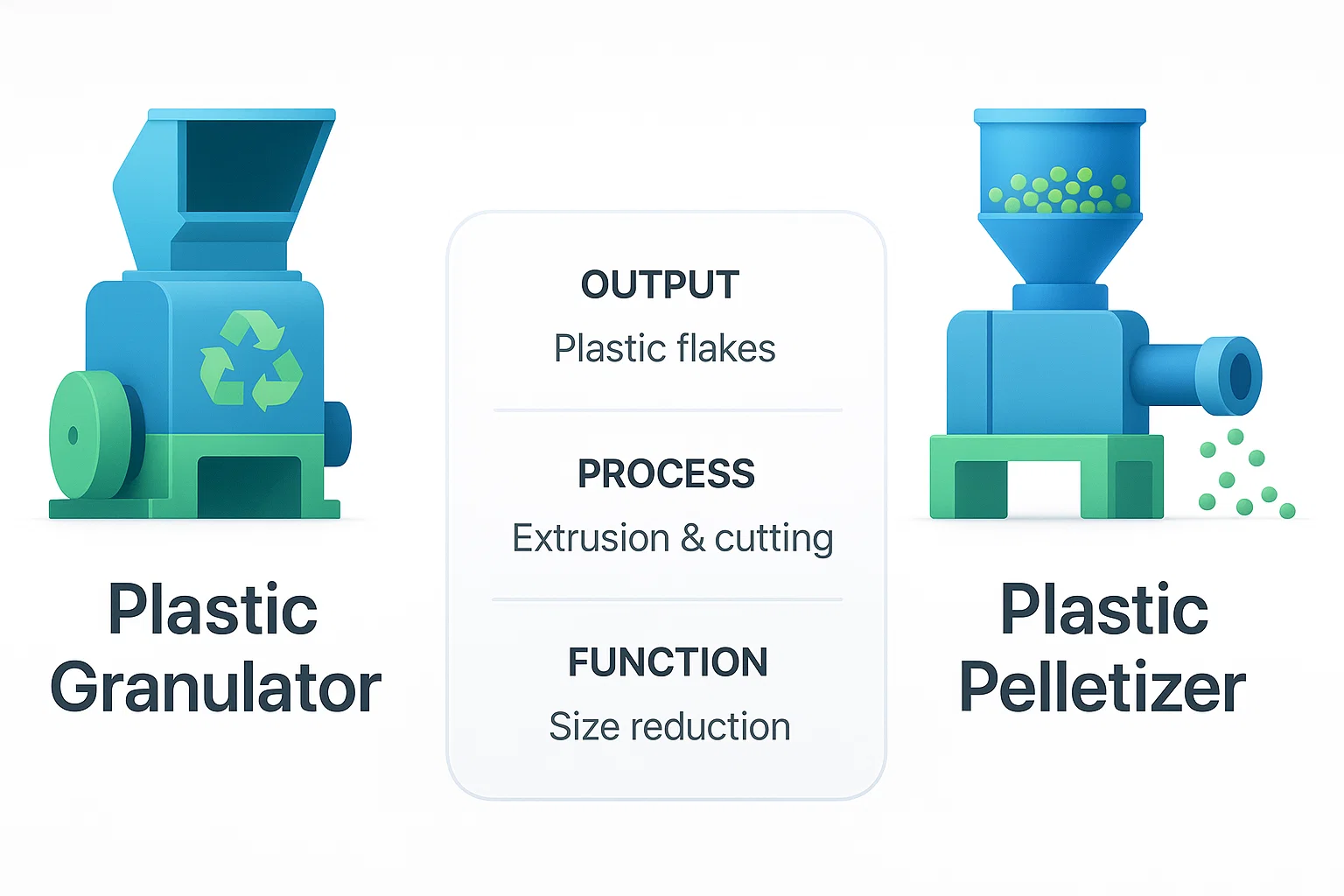W branży recyklingu tworzyw sztucznych wybór odpowiednich maszyn ma kluczowe znaczenie dla optymalizacji wydajności, jakości produktu i sukcesu operacyjnego. Dwa powszechnie omawiane elementy wyposażenia to granulatory I granulatory, ale co dokładnie je wyróżnia? Energetyczny, specjalizujemy się w dostarczaniu najnowocześniejszych rozwiązań maszyny do recyklingu plastiku, w tym oba granulatory do plastiku I granulatory plastiku, dostosowane do potrzeb profesjonalistów zajmujących się recyklingiem przemysłowym, inżynierów i nabywców sprzętu. W tym artykule omówiono kluczowe różnice między peletyzatorami i granulatorami, ich zastosowania oraz sposób wyboru odpowiedniego sprzętu do operacji recyklingu.
Zrozumienie granulatorów i peletyzatorów: przegląd
Zarówno peletyzatory, jak i granulatory odgrywają istotną rolę w przetwarzaniu odpadów z tworzyw sztucznych, ale w procesie recyklingu służą różnym celom. granulator redukuje materiały plastikowe do mniejszych, łatwych w obsłudze kawałków, podczas gdy granulator przekształca te elementy w jednolite peletki nadające się do dalszej produkcji. Rozłóżmy ich funkcje, projekty i zastosowania, aby zapewnić przejrzystość profesjonalistom z branży.
Czym jest granulator plastiku?
A granulator plastiku jest maszyną przeznaczoną do rozdrabniania lub mielenia odpadów z tworzyw sztucznych na małe, nieregularne płatki lub granulki, zazwyczaj o rozmiarze od 2 do 12 mm. Granulki te są często pierwszym krokiem w procesie recyklingu, przygotowującym materiały do dalszego przetwarzania, takiego jak wytłaczanie lub peletyzacja.
- Funkcjonować:Granulatory wykorzystują ostre ostrza lub wirniki do cięcia odpadów z tworzyw sztucznych (np. butelek, folii lub odpadów przemysłowych) na mniejsze kawałki.
- Wyjście: Granulki lub płatki o nieregularnym kształcie, idealne jako surowiec do dalszych procesów.
- Aplikacje:Stosowany do wstępnego rozdrabniania szerokiej gamy tworzyw sztucznych, w tym PET, HDPE, PP i PVC.
- Główne cechy:
- Szybkie systemy tnące zapewniające wydajne rozdrabnianie materiału.
- Solidna konstrukcja do pracy z twardymi tworzywami sztucznymi i zanieczyszczeniami.
- Możliwość dostosowania rozmiarów ekranu w celu kontrolowania wydajności granulatu.
Aby uzyskać więcej informacji na temat naszych wysokowydajnych granulatorów, odwiedź naszą stronę Strona granulatorów tworzyw sztucznych.
Czym jest granulator plastiku?
A granulator do plastiku, z drugiej strony, bierze przetworzony materiał z tworzywa sztucznego (często granulki z granulatora) i przekształca go w jednolite, cylindryczne peletki. Te peletki są bardzo poszukiwane w produkcji ze względu na ich spójny rozmiar, kształt i gęstość, co zapewnia płynne podawanie do wytłaczarek lub maszyn do formowania wtryskowego.
- Funkcjonować:Grillowniki topią i wytłaczają granulki plastiku, nadając im kształt jednolitych peletek poprzez matrycę.
- Wyjście:Spójne, cylindryczne granulki (zwykle o średnicy 2–5 mm).
- Aplikacje:Stosowany w końcowych etapach recyklingu w celu uzyskania wysokiej jakości granulatu do wytwarzania nowych wyrobów z tworzyw sztucznych.
- Główne cechy:
- Precyzyjna kontrola temperatury zapewniająca stałą jakość peletu.
- Zaawansowane systemy matryc zapewniające jednorodny kształt peletu.
- Opcje systemów peletyzacyjnych chłodzonych wodą lub powietrzem.
Odkryj naszą ofertę najnowocześniejszych rozwiązań w zakresie peletyzacji na naszej stronie Strona o granulatorach do tworzyw sztucznych.
Kluczowe różnice między peletyzatorami i granulatorami
Aby pomóc Ci podejmować świadome decyzje dotyczące Twoich działań związanych z recyklingiem, porównajmy peletyzatory i granulatory pod kątem kilku kluczowych czynników:
| Aspekt | Granulator plastiku | Granulator plastiku |
|---|---|---|
| Zamiar | Rozdrabnianie odpadów plastikowych na granulki/płatki | Formowanie granulek w jednolite peletki |
| Materiał wejściowy | Odpady z tworzyw sztucznych (np. butelki, folie, skrawki) | Wstępnie przetworzone granulki lub stopiony plastik |
| Wyjście | Nieregularne granulki lub płatki (2–12 mm) | Jednorodne cylindryczne granulki (2–5 mm) |
| Proces | Cięcie lub szlifowanie mechaniczne | Topienie, wytłaczanie i cięcie |
| Aplikacje | Początkowy etap recyklingu | Ostatni etap produkcji surowca |
| Złożoność sprzętu | Prostsza konstrukcja, skupiona na cięciu | Bardziej złożone, obejmujące ogrzewanie i wytłaczanie |
Diagram: Przepływ pracy w procesie recyklingu plastiku
Aby zilustrować rolę granulatorów i peletyzatorów, poniższy diagram przedstawia typowy proces recyklingu tworzyw sztucznych:
[Odpady z tworzyw sztucznych] → [Granulator: Redukcja rozmiaru] → [Granulat] → [Pelletyzator: Topienie i kształtowanie] → [Jednorodne granulki] → [Produkcja]W tym przepływie pracy pokazano, w jaki sposób granulatory i peletyzatory współpracują ze sobą, aby przekształcić surowe odpady z tworzyw sztucznych w wysokiej jakości surowiec do produkcji nowych produktów.
Wybór właściwego sprzętu dla Twoich potrzeb
Wybór pomiędzy granulator plastiku i granulator zależy od Twoich celów operacyjnych, typów materiałów i wymagań produkcyjnych. Oto kilka kluczowych kwestii:
- Rodzaj materiału i objętość:
- Granulatory są idealne do przetwarzania różnorodnych odpadów z tworzyw sztucznych, w tym materiałów sztywnych i elastycznych. Jeśli w Twoim zakładzie przetwarzane są duże ilości mieszanych tworzyw sztucznych, granulator jest niezbędny do początkowej redukcji rozmiaru.
- Granulatory nadają się do operacji nastawionych na produkcję wysokiej jakości, jednolitego pelletu na potrzeby konkretnych zastosowań produkcyjnych.
- Wymagania dotyczące produktu końcowego:
- Jeśli Twoi klienci wymagają granulatu o spójnej, wysokiej jakości do wytłaczania lub formowania, granulator jest niezbędny, aby spełnić te standardy.
- Granulki z granulatora mogą być wystarczające do mniej wymagających zastosowań lub jako etap pośredni.
- Integracja z istniejącymi systemami:
- Wiele zakładów recyklingu używa obu maszyn w sekwencji. Na przykład nasz granulatory plastiku sprawnie przygotować materiały dla nas granulatory do plastiku, zapewniając płynny proces recyklingu.
- Budżet i przestrzeń:
- Granulatory są na ogół mniej skomplikowane i bardziej ekonomiczne, dzięki czemu stanowią dobry punkt wyjścia dla mniejszych operacji.
- Granulatory z zaawansowanymi systemami wytłaczania mogą wymagać większych nakładów inwestycyjnych, ale zapewniają większą wydajność w przypadku producentów na dużą skalę.
Dlaczego warto wybrać maszyny do recyklingu tworzyw sztucznych firmy Energycle?
W Energycle rozumiemy wyjątkowe potrzeby profesjonalistów i inżynierów zajmujących się recyklingiem przemysłowym. granulatory plastiku I granulatory do plastiku są zaprojektowane z wykorzystaniem najnowocześniejszej technologii, aby zmaksymalizować wydajność, trwałość i jakość wyjściową. Oto, dlaczego nasz sprzęt się wyróżnia:
- Inżynieria precyzyjna:Nasze maszyny są przeznaczone do obróbki szerokiej gamy tworzyw sztucznych przy minimalnym przestoju.
- Rozwiązania niestandardowe:Oferujemy konfiguracje dostosowane do Twoich konkretnych potrzeb w zakresie recyklingu.
- Skupienie na zrównoważonym rozwoju:Nasz sprzęt jest zgodny z zasadami gospodarki o obiegu zamkniętym, co pozwala nam ograniczać ilość odpadów i tworzyć wartościowe produkty pochodzące z recyklingu.
- Wsparcie ekspertów:Nasz zespół zapewnia kompleksowe doradztwo, począwszy od wyboru sprzętu, poprzez jego instalację, aż po konserwację.
Wniosek
Podsumowując, różnica między granulator plastiku i granulator leży w ich funkcji, wydajności i roli w procesie recyklingu. Granulatory są niezbędne do rozbijania odpadów plastikowych na łatwe do opanowania granulki, podczas gdy granulatory przekształcają te granulki w jednolite peletki gotowe do produkcji. Rozumiejąc te rozróżnienia, możesz podejmować świadome decyzje w celu optymalizacji swoich operacji recyklingu.
W Energycle jesteśmy oddani wzmacnianiu Twojej firmy za pomocą najwyższej klasy maszyn do recyklingu. Niezależnie od tego, czy potrzebujesz solidnego granulator plastiku lub o wysokiej precyzji granulator do plastiku, nasze rozwiązania są zaprojektowane tak, aby dostarczać wyjątkowe rezultaty. Skontaktuj się z nami już dziś, aby omówić swoje wymagania i dowiedzieć się, jak możemy wesprzeć Twoje cele recyklingowe.



